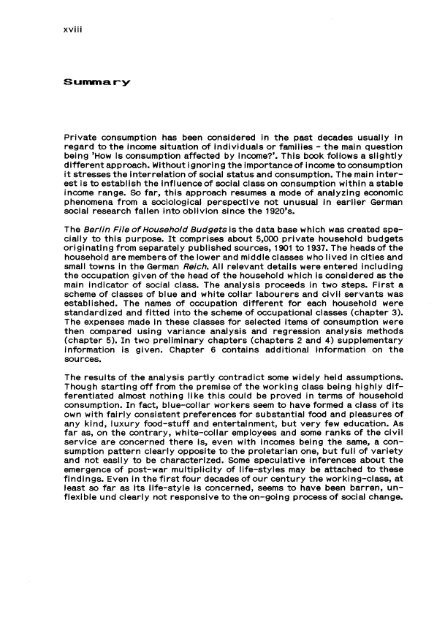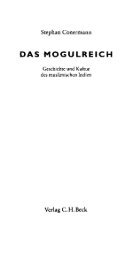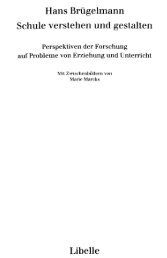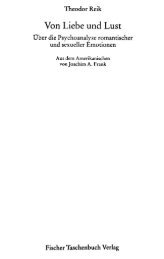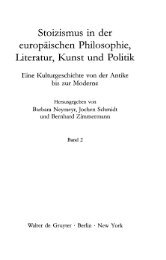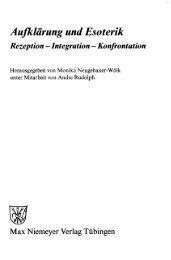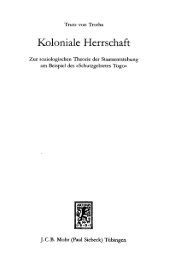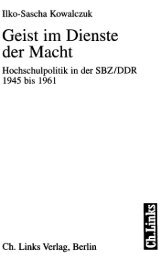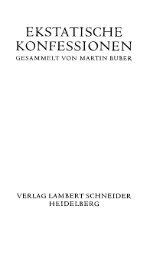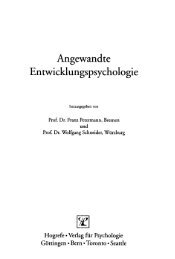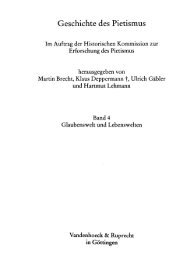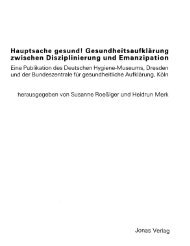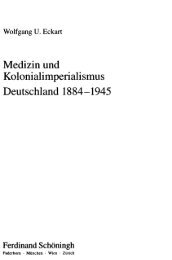- Seite 1 und 2: Materialien aus der Bildungsforschu
- Seite 3 und 4: Inhial "fcsver-zöl chn1 Band 1 Ver
- Seite 5 und 6: Band 2 6 Historische Haushaltsrechn
- Seite 7 und 8: Anzahl der Haushalte im Berliner Ge
- Seite 9 und 10: Beiträge an Vereine und Verbände
- Seite 11 und 12: Fette außer Butter Ausgaben für t
- Seite 13 und 14: Kleidung (und Wasche) Kleidungsausg
- Seite 15 und 16: Durchschnittsausgaben für Bekleidu
- Seite 17 und 18: - speziell: Hausrat Ausgaben für H
- Seite 19: Zusammenfassung xvii Die vorliegend
- Seite 23 und 24: Kapitel 1 (oder das Fehlen einer so
- Seite 25 und 26: Kapitel 1 Individuums und damit - i
- Seite 27 und 28: Kapitel 1 genauestens registriert,
- Seite 29 und 30: 8 Kapitel 1 stehende Schicht angest
- Seite 31 und 32: 10 Kapitel 1 Das Arbeitskräfteange
- Seite 33 und 34: 12 Kapitel 1 welches auf das Wechse
- Seite 35 und 36: 14 Kapitel 1 empirische Regelmäßi
- Seite 37 und 38: 16 Kapitel 1 schaftliehe Nachprüfb
- Seite 39 und 40: 18 Kapitel 2 Borchardts Wahrnehmung
- Seite 41 und 42: 20 Kapitel 2 durch einen allgemeine
- Seite 43 und 44: 22 Kapitel 2 ist in diesem Sinn auc
- Seite 45 und 46: 24 Kapitel 2 vom "Strukturwandel de
- Seite 47 und 48: 26 Kapitel 2 Standard für alle das
- Seite 49 und 50: 28 Kapitel 2 Eine Haushaltsrechnung
- Seite 51 und 52: 30 Kapitel 2 wurden, erklären die
- Seite 53 und 54: 32 Kapitel 2 gemeinen galt das Eink
- Seite 55 und 56: 34 Kapitel 2 Einschränkungen, die
- Seite 57 und 58: 36 Kapitel 2 verwandte Ausgabenquot
- Seite 59 und 60: 38 Kapitel 2 Man glaubte, jetzt 55
- Seite 61 und 62: 40 Kapitel 2 arten nicht zusätzlic
- Seite 63 und 64: 42 Kapitel 2 Die Gruppen B und C, d
- Seite 65 und 66: 44 Kapitel 2 Präferenzstruktur von
- Seite 67 und 68: 46 Kapitel 2 Kopfzahl zusammengeste
- Seite 69 und 70: 48 Kapitel 2 In den Abschnitten, wo
- Seite 71 und 72:
50 Kapitel 2 gen, und deren Haushal
- Seite 73 und 74:
52 Kapitel 2 Deutsches Reich 1925/2
- Seite 75 und 76:
54 Kapitel 2 Andeutungen der erwäh
- Seite 77 und 78:
56 Kapitel 2 piazierten sich die An
- Seite 79 und 80:
„Orientierungen" (Mentalität) 58
- Seite 81 und 82:
60 Kapitel 2 Beamten, die wie Anges
- Seite 83 und 84:
62 Kapitel 2 Maße, wie im Arbeiter
- Seite 85 und 86:
64 Kapitel 2 der Einzelbudgets als
- Seite 87 und 88:
66 Kapitel 2 zugunsten der eigenen
- Seite 89 und 90:
68 Kapitel 2 Diese Faktoren, bipola
- Seite 91 und 92:
70 Kapitel 2 einer größeren Verbr
- Seite 93 und 94:
72 Kapitel 2 direkt darbietet, besc
- Seite 95 und 96:
74 Kapitel 3 Tod 2 oder regionale D
- Seite 97 und 98:
76 Kapitel 3 Kleidung erklärend ei
- Seite 99 und 100:
78 Kapitel 3 Familie, ist ihre beru
- Seite 101 und 102:
80 Kapitel 3 tilgt [...] 20 . Mitte
- Seite 103 und 104:
82 Kapitel 3 Mit der beruflichen Ar
- Seite 105 und 106:
84 Kapitel 3 Versuch ein Schritt zu
- Seite 107 und 108:
86 Kapitel 3 spiel Eisendreher, Met
- Seite 109 und 110:
88 Kapitel 3 - GRUPPE2 liefert eine
- Seite 111 und 112:
90 Kapitel 3 klein ist 40 . Es kann
- Seite 113 und 114:
92 Kapitel 3 ANGESTELLTER,KFM.,VERT
- Seite 115 und 116:
94 Kapitel 3 KAMMERSEKRETAER,BERUFS
- Seite 117 und 118:
96 Kapitel 3 3.2.1 Von Berufsbenenn
- Seite 119 und 120:
98 Kapitel 3 Erläuterungen Die Bez
- Seite 121 und 122:
100 Kapitel 3 was ihre Gehälter al
- Seite 123 und 124:
102 Kapitel 3 lich-zünftischeZüge
- Seite 125 und 126:
104 Kapitel 3 ARBEITER:KUEHLSCHRAEN
- Seite 127 und 128:
106 Kapitel 3 MATERIALAUSGEBER MECH
- Seite 129 und 130:
108 Kapitel 3 Spezial berufe der Sc
- Seite 131 und 132:
110 Kapitel 3 der Flaschenmacher st
- Seite 133 und 134:
112 Kapitel 3 den Kratzenmaschinen
- Seite 135 und 136:
114 Kapitel 3 nicht aber bemerkensw
- Seite 137 und 138:
116 Kapitel 3 noch nicht gelungen s
- Seite 139 und 140:
118 Kapitel 3 stand war erst 32 Jah
- Seite 141 und 142:
120 Kapitel 3 Metallputzer Packer M
- Seite 143 und 144:
122 Kapitel 3 Aus dieser Liste wurd
- Seite 145 und 146:
124 Kapitel 3 Aber als selbstständ
- Seite 147 und 148:
126 Kapitel 3 Vorschmied Vorschloss
- Seite 149 und 150:
128 Kapitel 3 Installateur Klempner
- Seite 151 und 152:
130 Kapitel 3 Dreh er me is ter Eis
- Seite 153 und 154:
132 Kapitel 3 macherei vorformten,
- Seite 155 und 156:
134 Kapitel 3 Selbständigen waren
- Seite 157 und 158:
136 Kapitel 3 Arbeit leichter, der
- Seite 159 und 160:
138 Kapitel 3 ist die genaue Tätig
- Seite 161 und 162:
140 Kapitel 3 der Textilausrüstere
- Seite 163 und 164:
142 Kapitel 3 besorgten außerdem m
- Seite 165 und 166:
144 Kapitel 3 dar. Es befinden sich
- Seite 167 und 168:
146 Kapitel 3 3.2.3 Die Rangordnung
- Seite 169 und 170:
148 Kapitel 3 Die Laufbahngrenzen i
- Seite 171 und 172:
150 Kapitel 3 1871 und 1882 wurde d
- Seite 173 und 174:
152 Kapitel 3 tere Prüfung. In der
- Seite 175 und 176:
154 Kapitel 3 Direktoren der übrig
- Seite 177 und 178:
156 Kapitel 3 Präparandenanstalt e
- Seite 179 und 180:
158 Kapitel 3 Lehrer im ehemals nie
- Seite 181 und 182:
160 Kapitel 3 Telegraphenbauführer
- Seite 183 und 184:
162 Kapitel 3 2, Klasse Bauführer
- Seite 185 und 186:
164 Kapitel 3 Bergwerks- Oberschich
- Seite 187 und 188:
166 Kapitel 3 Zwischenkriegszeit Be
- Seite 189 und 190:
168 Kapitel 3 Sekretär, technisch
- Seite 191 und 192:
170 Kapitel 3 3.2.3.3 Amtsbezeichnu
- Seite 193 und 194:
172 Kapitel 3 Lademeister Lagermeis
- Seite 195 und 196:
174 Kapitel 3 Erläuterung Die Scha
- Seite 197 und 198:
176 Kapitel 3 3.2.4 AngestelItenber
- Seite 199 und 200:
178 Kapitel 3 Angestellte in leiten
- Seite 201 und 202:
180 Kapitel 3 modernen Entwicklung
- Seite 203 und 204:
182 Kapitel 3 vor 1914 3 Buchführe
- Seite 205 und 206:
184 Kapitel 3 Neben den Angestellte
- Seite 207 und 208:
186 Kapitel 3 sich - wie gelegentli
- Seite 209 und 210:
188 Kapitel 3 Abteilungspost oder b
- Seite 211 und 212:
190 Kapitel-3 Mittelstandes, Diese
- Seite 213 und 214:
192 Kapitel 3 den akademisch gebild
- Seite 215 und 216:
- Klassifikation soz1 Ungleichheit
- Seite 217 und 218:
196 Kapitel 4 Einkommenschichten, i
- Seite 219 und 220:
198 Kapitel 4 4.500 Mark im Jahr zu
- Seite 221 und 222:
200 Kapitel 4 In einer Studie über
- Seite 223 und 224:
202 Kapitel 4 Eine Trennlinie, die
- Seite 225 und 226:
204 Kapitel 4 Berufsteilungen als s
- Seite 227 und 228:
206 Kapitel 4 4.1.2 Neuere Modelle
- Seite 229 und 230:
208 Kapitel 4 Gibt es Gemeinsamkeit
- Seite 231 und 232:
210 Kapitel 4 zu bestimmen, verwend
- Seite 233 und 234:
212 Kapitel 4 als sie die Zweiteilu
- Seite 235 und 236:
214 Kapitel 4 Die Variablenstruktur
- Seite 237 und 238:
216 Kapitel 4 Diagramm 4.2 (2) Das
- Seite 239 und 240:
218 Kapitel 4 Prokuristen, Werkmeis
- Seite 241 und 242:
220 Kapitel 4 Diagramm 4,2 (3) Das
- Seite 243 und 244:
222 Kapitel 4 Dementsprechend ist d
- Seite 245 und 246:
224 Kapitel 4 Beginn dieses Jahrhun
- Seite 247 und 248:
226 Kapitel 4 treten, Haushaltsrech
- Seite 249 und 250:
228 Kapitel 4 nicht überschritten
- Seite 251 und 252:
230 Kapitel 4 Berufsgruppen sind ei
- Seite 253 und 254:
232 Kapitel 5 tung, zur Erweiterung
- Seite 255 und 256:
234 Kapitel 5 liär strukturierten
- Seite 257 und 258:
236 Kapitel 5 Forschung über sozia
- Seite 259 und 260:
238 Kapitel 5 ihres Einkommens für
- Seite 261 und 262:
240 Kapitel 5 zu steigen begannen,
- Seite 263 und 264:
242 Kapitel 5 Städte gewesen. Denn
- Seite 265 und 266:
244 Kapitel 5 Berufsgruppe Beamte m
- Seite 267 und 268:
246 Kapitel 5 Berufsgruppe Haushalt
- Seite 269 und 270:
248 Kapitel 5 Berufsgruppe Haushalt
- Seite 271 und 272:
250 Kapitel 5 Jahr 1903 1904 1905 1
- Seite 273 und 274:
252 Kapitel 5 und Kaffee und wieder
- Seite 275 und 276:
254 Kapitel 5 beanspruchte, mit etw
- Seite 277 und 278:
256 Kapitel 5 Anteil am Gesamtbudge
- Seite 279 und 280:
258 Kapitel 5 minderer Qualifikatio
- Seite 281 und 282:
260 Kapitel 5 1. Luxusnahrungsmitte
- Seite 283 und 284:
262 Kapitel 5 ("Schmierkäse "), He
- Seite 285 und 286:
264 Kapitel 5 Der Verbrauch hochwer
- Seite 287 und 288:
266 Kapitel 5 der Konjunktur, die d
- Seite 289 und 290:
268 Kapitel 5 Berufsgruppe Pro-Kopf
- Seite 291 und 292:
270 Kapitel 5 und von Angestellten,
- Seite 293 und 294:
272 Kapitel 5 wurde 78 . Ging man b
- Seite 295 und 296:
274 Kapitel 5 ab. Bei höheren Eink
- Seite 297 und 298:
276 Kapitel 5 Berufsgruppe Haushalt
- Seite 299 und 300:
278 Kapitel 5 nalen Ausgaben bereit
- Seite 301 und 302:
280 Kapitel 5 kommen. An den Ausgab
- Seite 303 und 304:
282 Kapitel 5 Gesamtbild. Die Konsu
- Seite 305 und 306:
284 Kapitel 5 und Obst in allen Ein
- Seite 307 und 308:
286 Kapitel 5 Berufsgruppe Haushalt
- Seite 309 und 310:
288 Kapitel 5 Im Hinblick auf den K
- Seite 311 und 312:
290 Kapitel 5 nen Einkommen zwische
- Seite 313 und 314:
292 Kapitel 5 sozioprofessionell be
- Seite 315 und 316:
294 Kapitel 5 Berufsgruppe Beamte
- Seite 317 und 318:
296 Kapitel 5 200 bis 300 RM in zw
- Seite 319 und 320:
298 Kapitel 5 Haushaltsrechnungen u
- Seite 321 und 322:
300 Kapitel 5 Für eine tätigkeits
- Seite 323 und 324:
302 Kapitel 5 Vielmehr verweist die
- Seite 325 und 326:
304 Kapitel 5 haushalte. Nach Mason
- Seite 327 und 328:
306 Kapitel 5 Konsumverhaltens zu e
- Seite 329 und 330:
308 Kapitel 5 sogar einkommensunela
- Seite 331 und 332:
310 Kapitel 5 wohl ihre durchschnit
- Seite 333 und 334:
312 Kapitel 5 Ressourcen bestimmt,
- Seite 335 und 336:
314 Kapitel 5 Ausgaben gemacht werd
- Seite 337 und 338:
316 Kapitel 5 Es ist auch das Kleid
- Seite 339 und 340:
318 Kapitel 5 "sozialen Stellung im
- Seite 341 und 342:
320 Kapitel 5 Verband ließ einen S
- Seite 343 und 344:
322 Kapitel 5 klassen gingen die an
- Seite 345 und 346:
324 Kapitel 5 Sind Differenzen inne
- Seite 347 und 348:
326 Kapitel 5 halten für die genan
- Seite 349 und 350:
328 Kapitel 5 gruppen gegeben. Dies
- Seite 351 und 352:
330 Kapitel 5 genossen buchstäblic
- Seite 353 und 354:
332 Kapitel 5 die Ausgaben der Ern
- Seite 355 und 356:
334 Kapitel 5 einstellen müssen. D
- Seite 357 und 358:
336 Kapitel 5 Monatsmieten (in der
- Seite 359 und 360:
338 Kapitel 5 Gesamtausgabenklasse
- Seite 361 und 362:
340 Kapitel 5 War der Abstand zwisc
- Seite 363 und 364:
342 Kapitel 5 sich nicht auf diese
- Seite 365 und 366:
344 Kapitel 5 Zahl dar Haushalte mi
- Seite 367 und 368:
346 Kapitel 5 bleibt der Unterschie
- Seite 369 und 370:
348 Kapitel 5 Berufsgruppe Haushalt
- Seite 371 und 372:
350 Kapitel 5 auffälligen Eigentü
- Seite 373 und 374:
352 Kapitel 5 und Möbel, die dort
- Seite 375 und 376:
354 Kapitel 5 Berufsgruppe Angestel
- Seite 377 und 378:
356 Kapitel 5 Anstieg ein Rückgang
- Seite 379 und 380:
358 Kapitel 5 5.2-3 Kultur und Ting
- Seite 381 und 382:
360 Kapitel 5 Kosten der Bildung un
- Seite 383 und 384:
362 Kapitel 5 Tabelle einen Auszug
- Seite 385 und 386:
364 Kapitel 5 Bedürfnisse zu befri
- Seite 387 und 388:
366 Kapitel 5 andere der ausgewähl
- Seite 389 und 390:
368 Kapitel 5 des 11 belief sich di
- Seite 391 und 392:
370 Kapitel 5 Es ist bemerkenswert,
- Seite 393 und 394:
372 Kapitel 5 reich fallen wiederum
- Seite 395 und 396:
374 Kapitel 5 5.000 RM vermehrt Sä
- Seite 397 und 398:
376 Kapitel 5 In der Weimarer Repub
- Seite 399 und 400:
378 Kapitel 5 verwendeten, gilt das
- Seite 401 und 402:
380 Kapitel 5 Berufsgruppe Qualifiz
- Seite 403 und 404:
382 Kapitel 5 Gesamtausgabenklasse
- Seite 405 und 406:
384 Kapitel 5 in die Schule kam ode
- Seite 407 und 408:
386 Kapitel 5 Gesamtheit - 1937 mit
- Seite 409 und 410:
388 Kapitel 5 und anteilmäßig wen
- Seite 411 und 412:
390 Kapitel 5 - auch prozentual - h
- Seite 413 und 414:
392 Kapitel 5 bildete in fast jeder
- Seite 415 und 416:
394 Kapitel 5 Das Budgetierungsverh
- Seite 417 und 418:
396 Kapitel 5 beibehielt, veränder
- Seite 419 und 420:
398 Kapitel 5 gewendet - mehr als b
- Seite 421 und 422:
400 Kapitel 5 betrug damit nur die
- Seite 423 und 424:
402 Kapitel 5 verwendeten, von den
- Seite 425 und 426:
404 Kapitel 5 unsere kinderlosen un
- Seite 427 und 428:
406 Kapitel 5 Gesamtausgaben für N
- Seite 429 und 430:
408 Kapitel 5 mittleren Beamten die
- Seite 431 und 432:
410 Kapitel 5 aus (47 RM) und opfer
- Seite 433 und 434:
412 Kapitel 5 Spareinlagen der meis
- Seite 435 und 436:
414 Kapitel 5 deutlich stärkere Bi
- Seite 437:
416 Kapitel 5 Tendenzen zur mentali


